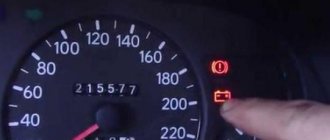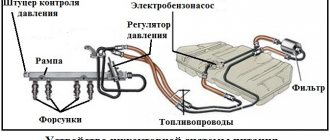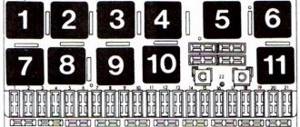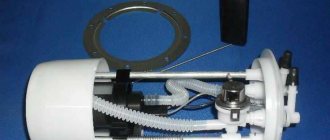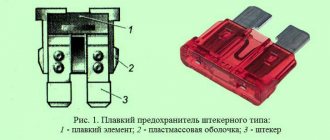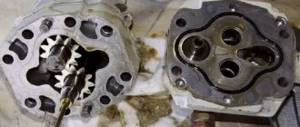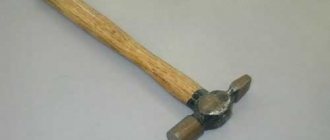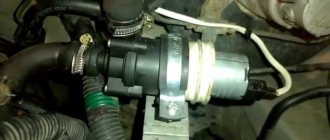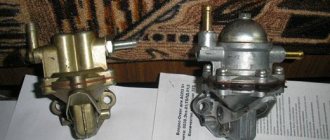Owners of cars with high mileage are often faced with the phenomenon of dropped or completely absent pressure in the fuel line. The reasons can be very different: a blown fuse, a faulty fuel pump relay, wear on the pump itself, clogged filters or leaks in the fuel system.
It is not always possible to immediately determine where exactly the problem lies. This is due to the fact that some symptoms may indicate completely different problems. For example, if the engine has become “dull”, responds poorly to the gas pedal, and does not develop full power - this may indicate anything, from low-quality fuel to an incorrectly set ignition.
Signs of a faulty fuel pump
Of course, in order to make a correct diagnosis, it is necessary to compare several symptoms. They may not appear all together, but the presence of several already suggests that the problem lies in the fuel pump.
- Changing the sound of the engine. The engine runs smoothly, without any extraneous sounds, and does not stall, but the tonality of the sound changes. This phenomenon may occur periodically, for example, when warming up, and then the sound becomes normal again, or the motor suddenly starts working in a different tone, and the sound tone does not change again until it stops working. This is one of the first signs that the fuel pump deserves more attention.
- The engine does not develop the required power. This phenomenon becomes especially noticeable in situations where you need to quickly overtake another car, or when driving uphill (the engine begins to “tighten”). Often this symptom occurs after a major overhaul of the power unit, due to an incorrectly set ignition or due to low-quality gasoline poured at an accidental gas station.
- The engine is difficult to start. It is not always possible to start the engine on the first try; you have to run the starter for a long time. This symptom in itself may well indicate a faulty starter or weak battery. And these are the easiest places to start checking. It is also worth paying attention to the ambient temperature, since an old or weak battery can quite easily cope with its task in the summer and fail at the first frost.
An important sign is how easy it is to restart an already warmed-up engine. If it starts easily after warming up, then the problem is most likely not in the fuel pump.
Causes of fuel pump problems
Before checking the fuel pump, a few words should be said about the reasons leading to a “sudden” breakdown.
- First of all, the pump may fail for those who like to drive with an empty tank. The submersible fuel pump is cooled by fuel. If the fuel level in the tank is too low, the rubbing parts begin to overheat intensely and wear out quickly. Sooner or later this will lead, at a minimum, to a drop in pressure in the power system.
- The pump may burn out due to faulty wiring. For example, if a fuse is installed that is designed for a larger current than it should, and a short circuit or voltage surge occurs (some “craftsmen” close the burnt fuse with a wire and continue to drive carelessly). A faulty fuel pump relay can also cause a breakdown.
- Dirt and dust entering the tank can also cause damage. Rust can form on the walls of the metal tank, which, once it gets into the pump, leads to damage to its parts. In addition, dirt deposits build up on the walls of the fuel tank, which then peel off and clog the coarse filter, resulting in a drop in fuel pressure.
Fuel pump diagnostics
When the first signs of a fuel pump malfunction appear, you should check its fuse. As a matter of fact, if any device in a car fails, you should first check the corresponding fuse. As practice shows, it is this small element that is often the source of trouble.
After this, you need to inspect the fuel line for leaks. Particular attention should be paid to the joints of hoses and tubes. The next step is to check the electrical contacts and fuel pump relay. Over time, contacts may oxidize. Sometimes cleaning them is enough to solve the problem.
Next, use a voltmeter to measure the voltage at the pump terminals. It should be approximately 12 V; if the engine is running, it may be more. It is important not to disconnect the block, since without a load the voltage on it is guaranteed to remain around 12 V, while under load it can significantly “sag” due to poor contact in the electrical circuit, as a result of which the performance of the fuel pump will sharply decrease.
If the first stage does not produce results (no leaks, fuse is intact, relay is working, voltage is normal), you need to check the pressure in the fuel system. Before starting the test, you need to relieve the residual pressure in the fuel system. To do this, disconnect the connector or remove the fuel pump fuse. Then you need to start the engine and let it run until the pressure in the power system drops to zero, after which the engine stalls itself.
Now you can take measurements. As a rule, there is a fitting on the fuel rail of cars to which a pressure gauge is connected. If there is none, then the device is connected using a tee to the fuel line between the fuel filter and the ramp. Then the ignition is turned on. The pump runs in boost mode for about two seconds. If it is working properly, then during this time it will have time to increase the pressure in the distributed injection system to 2.5 - 3.5 MPa, depending on the type of injection system. If the fuel pump does not have a boost mode, it can be turned on forcibly by closing contacts 30 and 87 on the relay.
What do the measurement results say?
If the pressure is too low or rises very slowly, it is necessary to find out the reason. The culprit may be either a worn fuel pump, a dirty fuel filter or a pressure regulator. To remove suspicion from the latter, you need to clamp the fuel drain line with a clamp. If the pressure increases, then the regulator is faulty.
If the pressure in the system is too high, it is necessary to disconnect the drain pipe and direct it into any suitable container. A drop in pressure indicates that the return line is clogged; if it does not change, the regulator is faulty.
After starting the engine, the pressure in the fuel rail should decrease by 0.5 MPa due to the fact that vacuum is applied to the pressure regulator. When you press the gas pedal sharply, it should remain unchanged.
Then you need to briefly clamp the fuel drain line or adapter hose after the pressure gauge. In this case, the pressure should double - this is the maximum that a working fuel pump is capable of.
No power coming to the fuel pump relay
Subscribe to topic
Notification by e-mail about replies to a topic during your absence from the forum.
Subscribe to this forum
Notification by e-mail about new topics on the forum during your absence from the forum.
Download/Print theme
Download the theme in various formats or view a printable version of the theme.
#1 diman36
#2 Djan
This problem turned out to be that power stopped coming to terminals 86 and 30 of the fuel pump relay. The car does not start and the check engine light does not come on. Where does the voltage come from and where to look for a possible fault?
#3 diman36
I just came across this the day before yesterday. And there were also problems with the stove and heated glass. Everything turned out to be very simple for me - bad contact on the 6th leg of the starter relay. My pump and heater were started from this relay by torsion of the starter, and after the engine started, the heater turned on. I don’t think the circuits will differ much between my car and yours. Although who knows, will tell you.
#4 play_angel67
#5 alekseyka77
Where does the voltage come from and where to look for a possible fault?
Attached files
- . 95.3.pdf 229.76K 524 Number of downloads:
#6 porter
#7 Djan
. Is this paw powering your pump relay?
#8 alekseyka77
There are no fuses there.
Hello everyone! There is no power supply to the fuel pump. The relay fuses are OK. What is the reason?
We didn’t conduct a survey on who had what body type.
by Adminrive · Published 10/30/2014
High fuel consumption
by Adminrive · Published 06/30/2015
Where is the relay located?
The part on cars is installed mainly together with all the fuses, but in some brands of cars there is also a different arrangement of devices. In cars with an injector, the relays can be located both under the hood and under the instrument panel. Most often, the fuel pump relay is located in the following places:
- Near the ABS blocks.
- Near the fuel injection control unit.
- Under the dashboard. Most often it is installed on the passenger side under the dashboard.
Since the fuel pump relay ensures the supply of fuel, it is sometimes worth diagnosing the part so that an unpleasant breakdown does not cause a premature end to the trip.
How does the device work?
After the driver turns the key in the ignition switch, the relay begins its work. The part sends a signal to the fuel pump and it turns on for 2 - 3 seconds to achieve the required pressure in the rail. The relay turns off the pump and then it starts only when the engine is rotated by the starter or while driving. After stopping the engine, the relay turns off the fuel pump and relieves pressure. In the latest models of gasoline pumps, the device performs several additional functions:
- Acceleration. If the automatic transmission needs to increase speed, the relay can additionally turn on the pump to supply more fuel.
- Slowing down the engine speed. If the engine is running at maximum speed, the relay may temporarily turn off the fuel pump. Temporarily turning off the device allows you to normalize the number of engine revolutions.
Signs and Symptoms of a Bad Fuel Pump Relay
Let's start with the fact that the fuel pump is controlled through a relay according to the following general scheme:
- the driver inserts the key into the lock and turns on the ignition;
- after turning on the ignition, the relay turns on the fuel pump for 2-3 seconds, which is necessary to create pressure in the fuel rail.
- then you can hear a characteristic sound as the fuel pump relay clicks, which has turned off the fuel pump;
- subsequent operation of the fuel pump will be possible under 2 conditions: rotation of the engine by the starter during startup and further independent operation of the already running engine.
- after turning off the ignition and stopping the engine, the relay turns off the fuel pump immediately or after 1 second.
Also on some cars the device serves as a kind of engine speed limiter. If the engine speed approaches maximum and begins to exceed the permissible threshold, the fuel pump is switched off via a relay. The gasoline supply stops, the speed decreases, after which the element supplies power to the pump again.
It should be additionally noted that on some vehicle models the fuel pump does not turn on after turning the key in the ignition, but at the moment the driver's door is opened. This solution allows you to quickly start the engine, as it ensures that the necessary operating pressure is created in the fuel system in advance. In other words, the pump pumps gasoline until the driver decides to insert the key and start the engine.
We also recommend reading the article about what to do if the starter clicks but does not turn the engine. From this article you will learn about the main causes of this malfunction, as well as how to check the starter yourself.
If the relay malfunctions, then power may not be supplied to the fuel pump. The second option is that the pump hums or hums constantly, that is, it does not turn off a few seconds after the required pressure is created in the fuel line. In the first case, the engine often cannot be started because the pump does not pump and there is no gasoline in the fuel rail. In the second case, the fuel pump relay gets stuck (the fuel pump relay does not work) and the battery charge is consumed for the constant rotation of the fuel pump motor. Let us add that on some cars, starting the engine is possible even if there are certain malfunctions in the operation of the element, since the pump relay connection diagram allows the device to operate while the starter is cranking.
Signs of a relay failure
The operation of the relay is important for the entire vehicle. If the part fails, the engine may not start at all or stall. In some cars, the fuel supply system is designed in such a way that even if the relay breaks down, the fuel pumps continue to operate, but the amount of fuel consumed can increase significantly. Do not neglect the problem if it occurs, as this can lead to failure of the fuel pump. The main signs of a relay failure are:
- The engine does not start because there is no fuel supplied to the system.
- A constant hum from the fuel pump means the relay is not turning it off. Such a malfunction leads to excessive fuel consumption, battery discharge and premature wear.
- The HP operates even when the motor reaches the maximum permissible speed.
Signs of a faulty fuel pump relay
Despite the fact that the relay, at first glance, appears to be a simple component, it still plays a special role in the operation of the vehicle. Any malfunction of the relay immediately provokes a malfunction of the fuel pump. This, in turn, leads to problems starting and driving the car.
To search for information about the main symptoms of a malfunction, we used automobile forums. As it turned out, mainly three main factors will tell you about a relay malfunction.
- Engine failure. A faulty relay does not supply power to the fuel pump, which naturally leads to the engine stopping.
- The engine does not start. There is no power supply to the fuel pump which does not supply fuel to the system.
- No noise that can be clearly heard when the ignition is on.
- The pump hums constantly (it should turn off after reaching the optimal pressure).
Checking the fuel pump relay
In addition to the relay itself, it is also necessary to check the fuses. When a part overheats, a fuse trips, which prevents the device from restoring normal operation without replacing it. Fuses are cheap parts that are involved in the operation of many systems, so you must always have a supply of elements. Since there are different ways to check the fuel pump relay, you must first find out which option will be the most convenient. There are two main variations of verification:
- Multimeter or light bulb . The device allows you to obtain the most accurate information about the operation of the device, but it is quite rare. The light bulb must have a current rating of no more than 0.25 A. The lamp or device is mounted to replace the relay. When the engine starts, the device begins to display voltage, and the light comes on and does not blink during operation.
- Jumpers . Connecting new wires will allow you to see how the system works bypassing the relay. If, when starting the engine, the fuel pump begins to pump fuel, then the problem lies in the relay itself.
Operating principle of the fuel pump relay
The relay consists of two main parts:
- several pairs of plate-shaped, cantilever-mounted contacts, assembled in pairs in one group. Deflecting under the influence of the electromagnet armature, the moving part of the contacts comes into contact with its pair, thus closing the switched wiring;
- an electromagnet with an armature is an ordinary coil with a thin copper wire wound; when a control signal passes through the windings of the electromagnet, a magnetic field is formed, under the influence of which the armature is attracted to the working surface and closes pairs of contacts with each other.
